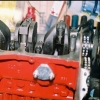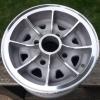
Confused About Valve Seals / Guides

Best Answer monkey , 16 October 2015 - 06:30 AM
To answer the op's question -
Valve guides are the metal sleeve that sits in the head that the valve stems slide through.
Valve stem oil seals are a rubber component that slides down the valve stem and sits on top of the valve guide to stop oil from the rocker assembly side of the head seeping down into the cylinder.
There are two designs on valve stem oil deals that I know of. The older simple o-ring or the newer top hat style.
Hope this helps
Steve.
Go to the full post 
#1

Posted 15 October 2015 - 07:15 AM
Are valve guides and valve stem oil deals the same thing? And do I need to replace them? (If I the head needs machining, the head gasket is going to have to wait, maybe for several months.)
Having read posts on TMF, I was planning on replacing the valve stem oil seals and lapping the valves.
Now I read that if you're replacing the valve guides, the valve seats need recutting.
The compression test I did was ok. (Can't remember what the numbers were but they were close to eachother and in the right range.)
The engine doesn't smoke.
So
If I'm replacing the valve stem oil seals, how do you do that? I can't find any instructions or youtubes for anything but modern engines.
#2

Posted 15 October 2015 - 07:23 AM
got a Haynes manual? have a read it cover the cylinder head quite well.
got a valve spring compressor?
#3

Posted 15 October 2015 - 07:57 AM
Im pretty sure I have everything I need.
Just trying to get confirmation on something that wasn't clear (to me, at least) from Haynes.
#4

Posted 15 October 2015 - 08:03 AM
Guides probably only need replacing if worn or you replace the actual valves.
Don't take everything you read on the internet as gospel! Ask the experts who rebuild heads regularly.
#5

Posted 15 October 2015 - 09:56 AM
Don't take everything you read on the internet as gospel!
+1 on that - everyone is a superhero genius on the net
except my self - obviously
- I'm super modest
oh by the way -
it's time lapse but you can see him installing the later top hat style , stem oil seal - some are just an 'o' ring
#6

Posted 15 October 2015 - 10:01 AM
Replacing the guides is something you'll need to get pressed in, not a tap in job.
#7

Posted 15 October 2015 - 10:39 AM
Blimey .. wasting his time there ...
1) Lap all the valves first one-by-one ... keep them in the correct order in a block of drilled wood or perspex
2) fit the lower spring spacers or caps (if necessary)
3) fit the valve seals (all together or as you fit each valve)
4) install the valves, springs, collets, etc
I turned my head over once after lapping to build mine .. guess it would be good upper arm exercise to flip it over and back 8 times!
Also, I should have added earlier that some valve guides do not have the small groove near the top for the top-hat seals to catch on ... I don't know whether these would work properly on those guides and you may have to use the earlier 'do-nut' type.
#8

Posted 15 October 2015 - 11:33 AM
If I'm replacing the valve stem oil seals, how do you do that? I can't find any instructions or youtubes for anything but modern engines.
http://www.austinamericausa.com/
On the left column, go Technical Advice, Engine, then near the bottom of page you will find the instruction to change valve stem seal. I followed them and changed all successfully, used to consume a litre of oil every 2000km, after changing no visible consumption so far for 1000km.
#9

Posted 15 October 2015 - 01:46 PM
Don't take everything you read on the internet as gospel!
+1 on that - everyone is a superhero genius on the net
[...]
it's time lapse but you can see him installing the later top hat style , stem oil seal - some are just an 'o' ring
Something on the web might not be acurate? Surely that can't be! ![]()
I had a look at the time lapse, and to be honest I'm not entiely sure which bit covers the valve seals, but if I watch it again when I've fot the head on the bench I'm sure it will all make sense.
Edited by fenghuang, 15 October 2015 - 01:46 PM.
#10

Posted 15 October 2015 - 01:52 PM
watch after he starts lapping in. turns head over, fits seal then fits springs, etc
At 15 mins he does the first one, but it's actually hard to see.
About 16 mins in shows one in close-up!
Edited by gazza82, 15 October 2015 - 04:49 PM.
#11

Posted 15 October 2015 - 07:10 PM
Take it easy and keep calm. You write: The compression test I did was ok. The engine doesn't smoke.
So, you can be sure there is not so much wrong with you engine.
You can see for yourself if the surface of the head and the surface of the block are really flat by using a window pane. Glass is as flat as can be. So put a peace of window pane on the surface of the head and over the surface of the block and it will be obvious when the surface of the glass and the surface of the block or head do not entirely meet each other. When you make the surface wet with water, it is the more obvious where the sufaces don't meet.
Because the compression is all right. You do not to have any hesitation to the question if the valve guides are all right; they are!
You have not to question if the valve rims do seal proper in the valve seats; they do!
So, you only have to apply new valve stem seals on the intake valves. The outlet valse have pressure beneeth them when they are open, so, oil that is coming down the valvestems inside the valve guides is pressed back into the rockerbox. Under the inletvalves there is a vacuüm when the valve is open, so it makes sense to prohibit oil to run down the valve stem between the valve guide, because oil lowers the octane of the fuelmixture and that is of no good to the efficiency of the engine.
#12

Posted 15 October 2015 - 08:28 PM
some fair points made by wim to be honest
I'm not sure a head gasket can be on its way out can it? its either gone or its ok? or is that wrong?
Edited by Fast Ivan, 15 October 2015 - 08:29 PM.
#13

Posted 15 October 2015 - 08:57 PM
#14

Posted 15 October 2015 - 09:40 PM
I would expect that on a road car due to the lower duration of the exhaust period, the pressure pushing up the guide would be more consistent than with a hotter cam where the late closing could actually pull a vacuum in the port at the very end, so I don't see how exhaust valve seals will do much on a road car. They might reduce a tiny bit of oil burning from it running down the guide after shutting the motor off, but that may also contribute to guide and exhaust valve stem life.
#15

Posted 16 October 2015 - 06:30 AM Best Answer
Valve guides are the metal sleeve that sits in the head that the valve stems slide through.
Valve stem oil seals are a rubber component that slides down the valve stem and sits on top of the valve guide to stop oil from the rocker assembly side of the head seeping down into the cylinder.
There are two designs on valve stem oil deals that I know of. The older simple o-ring or the newer top hat style.
Hope this helps
Steve.
1 user(s) are reading this topic
0 members, 1 guests, 0 anonymous users




















